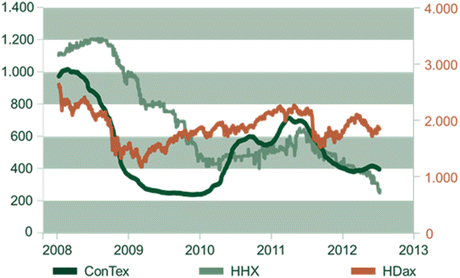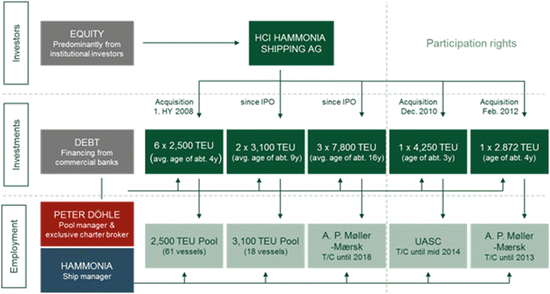HCI Hammonia Shipping AG: A Case Study

Company
Market segment
Date of IPO
Current market capitalization (in million euros)
Stock exchange
DryShips
Bulker
February 2005
936
NASDAQ
Diana Shipping
Bulker
March 2005
578
NYSE
Genco Shipping and Trading
Bulker
July 2005
163
NYSE
Seaspan Corporation
Container
August 2005
1,010
NYSE
Danaos
Container
October 2006
437
NYSE
First Ship Lease Trust
Misc.
March 2007
81
Singapore
Rickmers Maritime
Container
May 2007
88
Singapore
Paragon Shipping
Bulker
August 2007
30
NYSE
Seanergy Maritime
Bulker
September 07
24
NASDAQ
Holdings Corp.
Global Ship Lease
Container
August 2008
159
NYSE
Costamare Inc.
Container
November 2010
881
NYSE
Germany’s KG market developed further, but remained tailored to the needs of retail investors. An explanatory approach for the absence of investment vehicles for institutional investors respectively investment vehicles at the German stock exchanges up to 2007 may be the ample success of the KG market which did not necessitate efforts of ship managers and issuing houses to accommodate the needs of institutional investors with tailor-made structures. Alone in the years from 1999 to 2007, the equity raised from retail investors increased from EUR 1 billion p.a. to about EUR 3 billion p.a.
The main obstacle for institutional investors to join a KG fund is the legal structure. Investment guidelines of banks, savings banks, and insurance companies generally require investments in publicly listed companies to ensure a daily price fixing and in addition a simplified exit option from the investment. In addition, private limited partnerships (Kommanditgesellschaften) do not fulfill the custody qualifications (Depotfähigkeit). Private limited partnerships are therefore for the most part not considered an eligible investment vehicle even though secondary markets for KG shares have been established.
In 2007 and 2008 three alternative shipping investment vehicles were publicly offered in the German market structured as public limited companies (Aktiengesellschaft) to tap into the market of institutional investors (Table 8.2).
Table 8.2
Listed shipping companies in Germany
Company | Market segment | Date of IPO | Current market capitalization (in million euros) | Stock exchange |
|---|---|---|---|---|
MARENAVE | Misc. | November 2006 | 69 | Hamburg |
HCI Hammonia | Container | November 2007 | 35 | Hamburg |
Shipping AG | ||||
Vilmaris | Bulker | June 2009 | 30 | Hamburg |
The initiators were issuing houses and ship managers with the objective to also develop access to the capital markets to diversify funding sources and to safeguard future growth. In the following chapters an abstract based on the experiences gained in recent years shall be given with regard to one of those investment vehicles, the HCI Hammonia Shipping AG (“HHX”), paying particular consideration to its distinctive features and differences to the prevailing ship investment vehicles in Germany at that time.
8.2 Initial Public Offering
HSH Nordbank AG, Nord LB and HSC Hanseatische Sachwert Concept GmbH (a subsidiary of HCI Group) were entrusted with the placement of the shares. Preparations for the IPO of HHX started at the beginning of 2007. However, the presentation to potential investors commenced only in the middle of 2007. Target investors were especially banks, savings banks, pension funds, and insurance companies. A minimum subscription of EUR 550,000—i.e. 500 shares at EUR 1,100 each—was set deliberately to allow for a lean fund raising process. However, smaller amounts of shares could be ordered at the stock exchange. Some retail investors used that opportunity following the initial listing.
The marketing of the IPO was hampered by the fact that in August 2007 a rescue package had to be bundled to secure the solvency of IKB Deutsche Industriebank AG. At this KfW bore the brunt to avoid a chain reaction in the German banking market. This was the first forerunner of the transgression of the US subprime crisis to the German banking market and it led to respective disconcertment in the financial sector. However, the IPO of HHX could be completed successfully. The original target to raise €130 million of equity was slightly surpassed with a final volume of €150 million. Since the IPO, the shareholder structure has basically remained unaltered and is as of August 2012 (Fig. 8.1).


Fig. 8.1
Investors breakdown
8.3 Company Structure
HHX is a management holding company in the legal form of a public limited company. Its shares are listed in the regulated market of Hanseatische Wertpapierbörse Hamburg (‘Hamburg Stock Exchange). It has also been listed by brokers in the regulated unofficial markets (Freiverkehr) at the stock exchanges in Frankfurt, Munich, and Stuttgart whereby a Designated Sponsor attends to the listing in the XETRA system. HHX holds interests in limited shipping partnerships with a limited liability company as general partner (GmbH & Co. KG). These limited shipping partnerships are in turn the owners of the respective vessels.
The current fleet of HCI Hammonia Shipping AG includes 13 container vessels. In addition to the previous eleven vessels of the 2,500, 3,100 and 7,800 TEU classes, a majority interest of 56 % in a 4,250 TEU vessel was acquired in December 2010 and a majority interest of 51 % in a 2,872 TEU vessel in February 2012. The chart (Fig. 8.2) shows the current organizational structure.


Fig. 8.2
Structure of the investment scheme
8.4 Business Model
The business concept of HHX is focused on the acquisition, operation, and sale of merchant ships. Market cycles shall be used to sell ships at high prices and replenish the fleet when prices are lower. HHX is merely an asset holder. The shipping companies of HHX provide the vessels’ charterers with fully equipped, operational, and manned vessels.
8.4.1 Focus on Container Shipping
Through limited shipping partnerships, HHX operates a fleet of container ships. An expansion into other ship segments (e.g. bulk carriers) has been left open in the IPO prospectus. However, it has always been the concept of the management to focus on container shipping. While this takes away the possibility to diversify earnings over different shipping segments, the idea was to leave the decision whether to diversify (and if so, to which extent) to the investors as pure bulk carrier and pure tanker stock companies are available in the international stock markets. This is also a concession to institutional investors who carry out their own portfolio management. HHX’s focus on container shipping is a distinctive feature to the other comparable investment vehicles in the German market.
8.4.2 Involvement of the Initiators
HHX has no own employees. All services are provided by means of outsourcing whereby HHX is a “true lean company”. By using the resources and the skills of its initiators, HHX benefits from their market positions. The involvement of its initiators is an essential feature of the business model of HHX.
8.4.2.1 HAMMONIA Reederei GmbH & Co. KG
All vessels are commercially and technically managed by HAMMONIA Reederei GmbH & Co. KG (“HAMMONIA Reederei”) which is a ship management company and project developer in international shipping. Originally founded by ship owner Peter Döhle Schiffahrts-KG (“PDS-KG”) and issuing house HCI Capital AG in 2003, today HAMMONIA Reederei is a joint venture between three companies: Alongside PDS-KG and HCI Capital AG, GE Transportation Finance (part of General Electric Corp. US) joined as shareholder in 2008. HAMMONIA Reederei manages a range of vessels. Presently1 the HAMMONIA Reederei fleet comprises 51 container vessels, 2 bulk carrier and also 15 multipurpose vessels. HAMMONIA Reederei provides HHX with a ship management of good reputation. In addition, they prepare in collaboration with the tax counsellor the quarterly reporting of the shipping companies based on the International Financial Reporting Standards (“IFRS”), a service which is deemed pivotal.
8.4.2.2 Peter Döhle Schiffahrts-KG
Being the exclusive broker, PDS-KG is in charge of the deployment of the HHX vessels, either in earnings pools or on a pure time charter basis. PDS-KG was founded in 1956 as an agent to ship owners (“Vertrauensmakler”) to conduct commercial maritime services. PDS-KG acts not only as broker for its own and part-owned fleet but also on an exclusive basis to others such as HHX. Today the company manages the chartering for a modern fleet of around 400 container vessels, multipurpose vessels and bulk carriers. The market access of PDS-KG is a distinguishing factor for HHX.
8.4.2.3 HCI Capital AG
HCI Capital AG respectively its legal predecessor (“HCI”) was founded in 1985 and has developed to be one of the leading issuing houses in the German market. As of August 2012 main shareholders of HCI are the Döhle Group (25.6 %), MPC Capital AG (25.6 %) and HSH Nordbank AG (19.9 %). A particular focus has always been on closed-end funds in the shipping segment: In total equity for more than 500 vessels, respectively more than EUR 4 billion has been raised over time. As a stock listed company, HCI is familiar with the respective regulative requirements. HCI provides commercial support for HHX being responsible for the coordination of the quarterly financial reporting, the organization of annual general meetings and supervisory board meetings, investor relationship management and compliance with legal regulations and corporate governance.